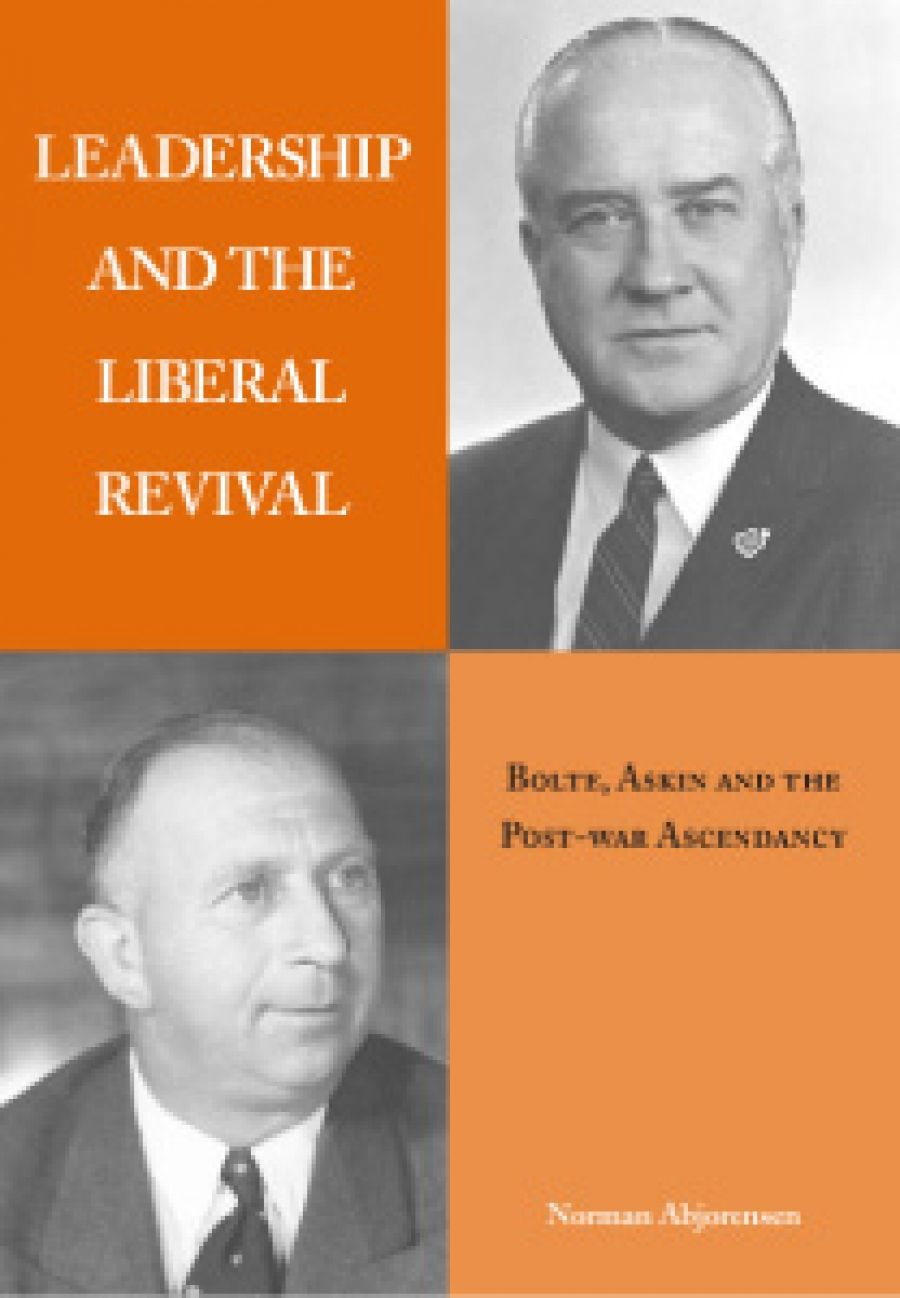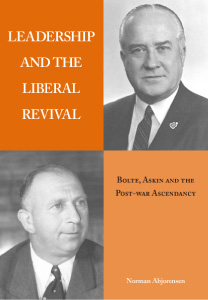
- Free Article: No
- Custom Article Title: Favourable winds
- Review Article: Yes
- Article Title: Favourable winds
- Online Only: No
- Custom Highlight Text:
Henry Bolte and Bob Askin were the ‘big men’ of state politics in the 1960s, when I was a young political scientist. Bolte I never met, and Askin I met only once, but I knew the latter’s deputy premier, Charlie Cutler, quite well. I grew up in northern New South Wales and throughout my life, it seemed, we had only ever had Labor governments. The premiers cycled by with an air of inevitable succession: McKell, McGirr, Cahill, Heffron, Renshaw. Yet all five had been there in 1941 when the rejuvenated Labor Party, free both of Jack Lang and the far-left opposition to him, trounced the Mair–Bruxner government at the polls. For anyone who had been through that quarter of a century, Labor’s narrow defeat in 1965 was a shock. How could it have happened?
- Book 1 Title: Leadership And The Liberal Revival
- Book 1 Subtitle: Bolte, Askin and the post-war ascendancy
- Book 1 Biblio: Australian Scholarly Publishing, $39.95 pb, 228 pp
- Book 1 Cover Small (400 x 600):

- Book 1 Cover (800 x 1200):

A comparable story occurred, rather earlier, in Victoria. The Liberal Party there almost had the status of a minor party, and was idealess, factionalised and easily bypassed, both by the Country Party and the ALP. Suddenly, it was in power in its own right, and it stayed there for a long time. How could that have happened?
Norman Abjorensen wrote a PhD thesis about these changes and about the two long-serving Liberals who led the revival; and the book of the thesis is a good read. You can find similar figures in the other states: Thomas Playford in South Australia, David Brand in the West, Joh Bjelke-Petersen in Queensland. All of them had some of the qualities possessed by Bolte and Askin, and all were successful electorally, too.
What were these qualities? For Abjorensen, the crucial one was what I would call ‘the common touch’, the capacity to be seen by the majority of the electorate as ‘one of us’. He notes that both Bolte and Askin (Brand and Playford, too) had all served as non-coms during the war, accustomed to leadership at their level but rubbing shoulders with the rank and file. For them, loyalty cut both ways: they expected it, and they gave it. Bolte’s care for the Labor men who had broken the Cain government and elevated him to power was continuous, long after they had served their purpose. Neither Bolte nor Askin was ever challenged for the leadership after he gained it. Both loved the nags, both had a larrikin side; neither had intimate friends in politics, and both led quite separate private lives. They stood apart from the usual Liberal leaders. When they left, after a decade at the top, their party would soon be defeated.
Askin was quite clear about electoral success: the Liberal Party had to move to the centre of politics, and he placed himself ten per cent to the right of centre. His feeling for whom he wanted to look after was similar to that of his Labor predecessors. He may have picked up some of the sense of the path to follow from Bolte’s earlier success and style, for Bolte had had an even stonier road to electoral success. Both became leaders of their party fairly early in their careers, were lucky in their circumstances and came to power through larger events. The Labor Split in 1955, centred in Victoria, almost guaranteed Bolte a victory. Ten years later, Askin benefited from prosperity, the continued Labor Split and the mistakes of an old and tired government. Once in, both cemented their position adroitly and ensured that the lessons of the defeat of their predecessors were learned well, not ignored. In time, of course, each lost that acute sense of electoral truth and left office as yesterday’s men.
I enjoyed the separate tales of these two formidable men, the stories enormously strengthened by the availability of the oral histories they and their colleagues had undertaken – what a treasure that archive is. But at the end I felt something was missing. Abjorensen’s story is really about personal style, and the other ingredients in politics get much less attention. You won’t find much about policy, save as the underpinning of style. So both Askin and Bolte picked up and articulated electoral grumpiness at over-regulation and powerful trade unions, plus the perennial discontents in a democracy such as ours: housing availability, education for children, inefficient public transport and so on. As premiers, each found himself unable to do much in these domains, though each profited from external circumstances while they were available.
Abjorensen understands that, throughout the twentieth century, Australians were clear that they liked private property in the form of houses and cars, and public services in the form of education, public transport and health services, without seeing any kind of contradiction in such a set of preferences. State premiers can’t do much that is fundamental here, since they have little freedom to engage in revenue generation and no freedom at all in service provision. You could argue that in state politics governments fall when people are fed up enough with what they are getting, and from that perspective Bolte and Askin were simply lucky. They were in the right positions at the right time, and had favourable winds for the next ten years or so. Bolte was, after all, regarded by many as ‘little more than an honest plodder’, while Askin kept his head well down during the early years of the state aid controversy. Were they really special?
Leadership and the Liberal Revival is a grander title than its contents warrant, but it should be on the bookshelf of anyone with a serious interest in Australian politics. Perhaps it will stimulate someone else to undertake a more comprehensive account of leadership in the politics of our states, now well over a hundred years old and in no sign of decay as political arenas.


Comments powered by CComment